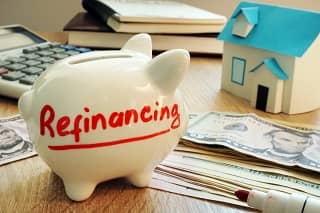 Mortgage rates have come down so precipitously that even homeowners who purchased or refinanced their properties fairly recently may be able to save even more by refinancing again.
Mortgage rates have come down so precipitously that even homeowners who purchased or refinanced their properties fairly recently may be able to save even more by refinancing again.
These days, you're probably thinking about pumpkin pie, not points, and cranberry sauce, not credit. But one thing you should be thinking about -- a lot -- is gravy. No, not the sauce, but the money you might free up by refinancing your mortgage. Here's how you can calculate your potential savings.
Mortgage refinancing: making tradeoffs
Refinancing isn't free; you have to pay for it somehow. The financing costs associated with your refinance do offset some of the money you can save on your new home loan. The primary goal when running the numbers on a mortgage refinance is determining what financing strategy saves you the most money over the long term (or, at least, over the period that you plan to hold your property).
If you've already refinanced your mortgage to take advantage of today's mortgage rates, then you've realized some of the potential savings. If that's the case, it's all the more critical that you understand when another refinance will or won't save you even more.
Whether it's your first refinance or not, once the decision is made, your next step is determining how you're going to pay for it. Here are your three options:
- Traditional Refinance: In this option, you pay the closing costs out of pocket at the closing table. While you get the benefit of the lower interest rate, you have to overcome your closing costs today before you realize any financial benefit.
- Low-Cash-Out Refinance: Instead of paying closing costs out of pocket, this option wraps the costs into the new loan amount. Since you are financing the costs, you'll not only pay the principal on them but the interest as well.
- No-Cost Refinance: If you're strapped for cash as well as equity when it comes time to close, this option may be your best bet. Essentially, a "no-cost" refinance trades the closing costs for a higher-than-market interest rate. We assume that the interest rate available for a "no-cost" refinance will be a half-percentage point higher than if you had paid the fees.
How should you think about these options? Given your time frame, is it better to pay closing costs upfront or take the no-cost option with the higher interest rate? Is it better to wrap closing costs into your new loan or write a check at closing? With a low-cash-out refinance, your loan amount will be higher, and you'll be paying interest on your refinancing costs. Yet this could mean you won't have to cash out other investments (which might have tax consequences) or raid your emergency savings to pay for the ability to refinance.
"Tri" HSH.com's new refinance calculator
Parsing these options can be overwhelming. Fortunately, HSH.com has created a new refinance calculator -- the "Tri-Refi Refinance Calculator" -- that allows you to make an easy side-by-side comparison of a traditional refi, a low-cash-out refi and a no-cost refi.
The refinance calculator presents you with a detailed analysis of how each payment method affects your mortgage costs over time. The refinance calculator allows you to see your long-term savings and pinpoint the time when you'll have paid off the refinance costs. After that breakeven point, your savings are all gravy -- the kind you can take all the way to the bank.
Thanks to this new tool, it's all the more easier to fit a refinance decision into your busy Thanksgiving schedule of family, food and football. If you give the Tri-Refi mortgage calculator a spin and realize there's more savings to be had, find a refinance lender who can take you through the rest of the process.



